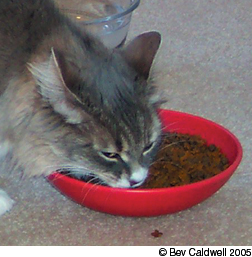Puzzling Increase in Lymphoma
Time was, before routine testing and vaccination of most cats against feline leukemia virus (FeLV), about 80 percent of lymphoma cases (cancer of the lymph nodes or other lymphatic tissue) stemmed from FeLV. So why – now that testing and vaccination programs have reduced the number of infected cats – is lymphoma in cats on the rise?

252
Researchers writing in the Journal of Veterinary Internal Medicine (Vol. 19, pp. 329-335) ponder that question, based on a 21-year survey of lymphoma cases at the University of California, Davis School of Veterinary Medicine. They suggest some possible reasons for the increase in non-FeLV lymphoma – and, as researchers love to do, they recommend further research.
One idea is that Siamese and other Oriental breeds have a genetic predilection for lymphoma. When other known risk factors occur (researchers point to tobacco smoke exposure and vaccine-associated sarcoma), a greater percentage of Siamese subsequently develop lymphoma.
Another supposed link – from renal disease and special diets to inflammatory bowel disease and eventually lymphoma – is even more complicated. Cat foods have changed in response to health issues, particularly urinary tract disease, the researchers note, and diet has been postulated as a cause of the increase in inflammatory bowel disease. Chronic inflammation, they suggest, may be a contributing factor in an individual cat predisposed to development of intestinal lymphoma.
———-
Link Between Renal Disease, Hypertension and Blindness
Speaking of renal disease, an article in the journal Clinical Techniques in Small Animal Practice (Vol. 20, Issue 2) caught our eye. Sadly, the article was missed by Gertie, the unofficial Short Takes cat, who is almost totally blind because of a cascade of medical misfortunes that began with her kidneys.
In the article, Ocular Manifestations of Systemic Disease in Cats, researcher N. C. Lacroix tells how feline hypertension (high blood pressure) often follows renal disease (as well as hyperthyroidism, diabetes mellitus, certain cancers or anemia) and what happens next: hypertensive retinopathy, disruption of pigmented retinal epithelium, subretinal edema, retinal detachment and hemorrhaging.
Retinal detachment was Gerties fate, although prescribed blood-pressure meds (similar to this writers, and tested first on humans!) seem to have reversed some of the damage. Thanks to sensitive whiskers and a good memory for furniture arrangements, she navigates well around household obstacles (sleeping dogs included).
The bottom line from the medical journal is: Have the blood pressure of older cats checked (systolic blood pressures above 160 or 170 mm Hg in cats are too high). Its more complicated (and costly) than the method used on humans. But prevention beats vision loss in an otherwise healthy cat.
———-
The Fifth Commandment
And for human peacekeepers in cat-dog land, heres some advice from the new book by Amy Shojai, Petiquette: Solving Behavior Problems in your Multi-Pet Household (M. Evans and Company, 2005). Under The Ten Commandments of Pet Dynamics, Shojais Commandment Five is: Newcomer cats must be familiar with the new environment before they are willing to meet resident dogs.
Imagine the Resident Dogs surprise when he returns from the morning walk to find a newly confident Resident Cat on his turf. See Commandment Eight for what to do next.



